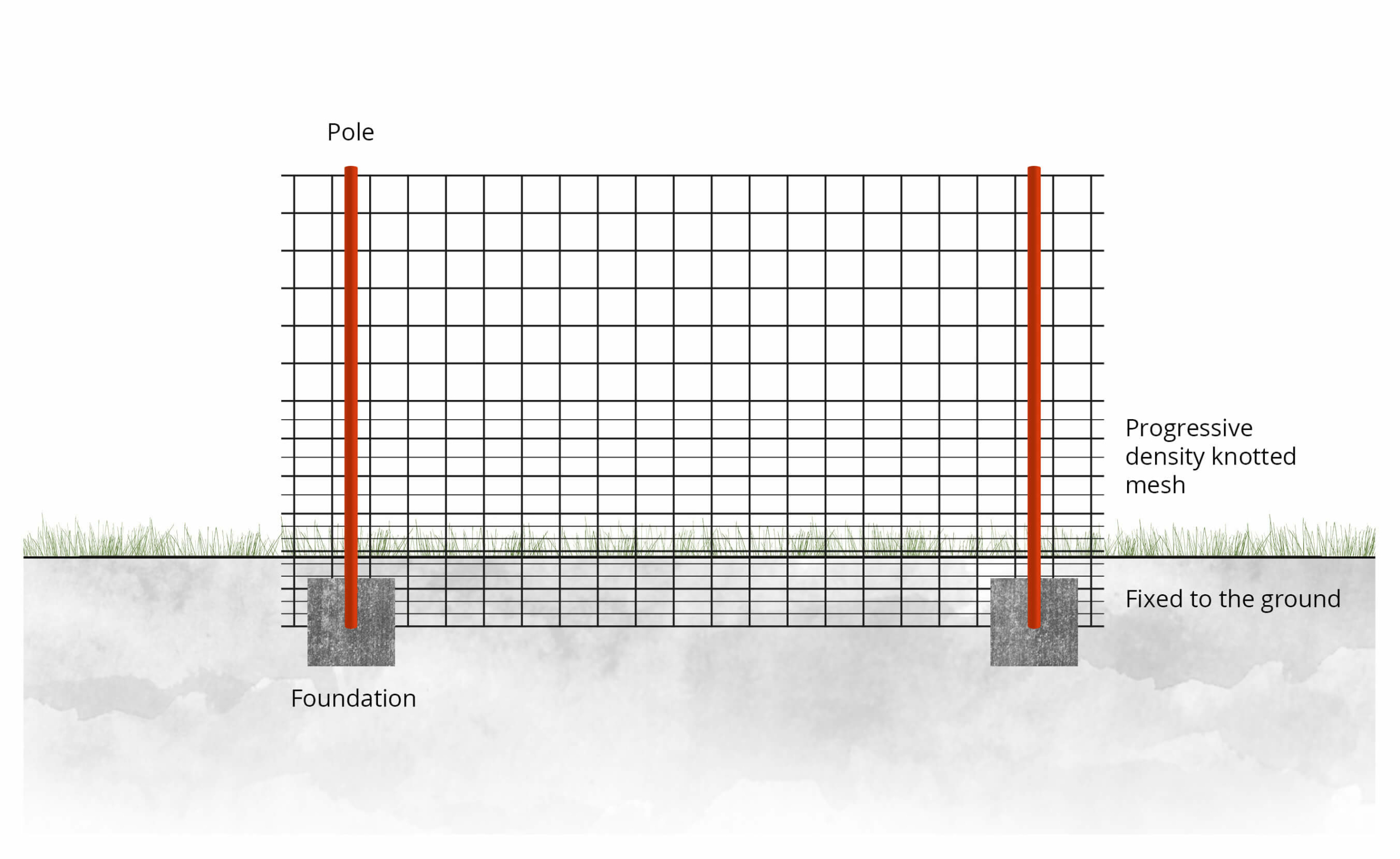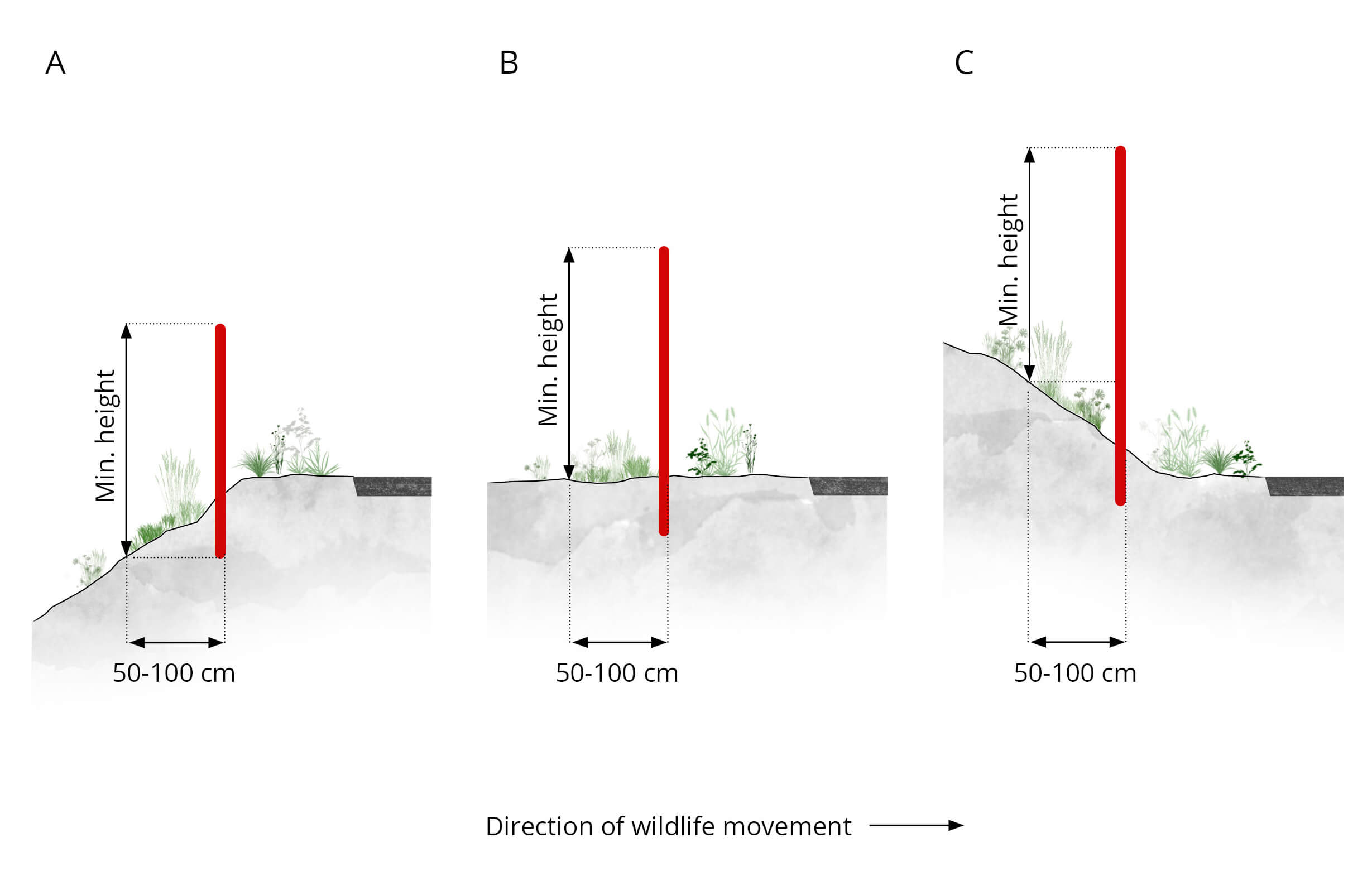RATIONALE. Fencing. Design and dimensions
There is a lack of published information regarding the effectiveness of the different types of fencing, mesh types, height and length (Rytwinski et al., 2016). The technical prescriptions regarding design and dimensions included in this present chapter are mainly based on knowledge and experience from infrastructure operators and experts from different countries (AT, Carpathian region, ES, FR, NL and SE) and guidelines and handbooks providing best practice (van der Ree et al., 2015; Animex, 2021).
When fencing is installed only on particular sections of the infrastructure, defining the appropriate fence length to prevent roadkill is particularly difficult. Any fence should be long enough to avoid or reduce the ‘fence-end effect’ (Clevenger et al., 2001; Spanowicz et al., 2020), which occurs when animals such as ungulates follow fencing and cross the infrastructure at the point it ends. To avoid this effect, fence ends must always be connected to crossing structures. When this is not feasible, fence ends must be placed in areas where animals do not tend to cross (Clevenger and Huijser, 2011) or in areas with high visibility to drivers (Barthelmess et al., 2014).
Jaeger & Re (2021) developed models to assess appropriate length according to target species’ home range and location regarding fencing where a percentage of roadkill reduction (effectiveness) is calculated as %E = 1 – 0.226*R/L, where R is the radius of the target species home range and L is the length of the fence. A similar approach was developed by Seiler et al. (2015) to determine a standard for the maximum length of a fence to avoid barrier effect for ungulates in Sweden, determining that, in the study area, fences longer than 6 km require combination with crossing structures.
Conventional wildlife fences consist of wire mesh fixed to regularly-spaced poles that should be buried into the ground or, if this is not possible, appropriately anchored to avoid wildlife passing under the mesh (Figure 5.2.7). The basic model could be complemented with reinforcements to avoid access by specific target species, such as amphibians, large mammals, climbers or burrowing species (see Section 5.2.4 – Fencing and reinforcements for small vertebrates and Section 5.2.5 – Adaptation of existing fences and other systems to deter burrowing animals).
The characteristics of the fence (i.e., height, mesh type) must be defined according to target species and following these criteria:
- Fence is of sufficient height to discourage large mammals from attempting to jump over it (Figure 5.2.8).
- Mesh (or any other material to be used) is of the correct type, size and condition to prevent target species passing through or climbing over it. The mesh is durable and reduces the risk of entangling and injuring animals (Figure 5.2.9 and Figure 5.2.10).
- Mesh is appropriately buried in or anchored to the ground to ensure animals cannot access the infrastructure by going underneath it.
- Fence fixings and base anchoring are properly installed or the base of the fence buried to prevent animals passing under the fence (see Section 5.2.6 – Poles and Section 5.2.5 – Adaptation of existing fences and other systems to deter burrowing animals).
Wildlife often try to cross infrastructure looking for more suitable habitats. Ecological restoration of target species’ habitats to attract them to particular sites could be part of the fencing strategy. These alternative, quality habitats could play a role in reducing the need for fencing or helping to reduce the cost of bigger and more robust fences because the animals don’t attempt to cross as frequently.
Recommended fencing, including mesh type and other materials to be used and dimensions according to target species, is shown in Table 5.1.
Table 5.1 – Dimensions and type of fences suitable for different species or groups of species according to standards in different European countries (see Rationale box. Fencing. Design and dimensions). Fencing design and dimensions should be adapted to target species and site conditions (Figure 5.2.11).
| Target species | Height (cm; above ground) | Material; Mesh type | Mesh density (cm) | Accessories | Installation |
| Red deer, Fallow deer, Moose, Rein deer | 200 – 240 | Knotted mesh Regular or progressive density2.5 mm galvanized wire | Progressive mesh: W = 10 – 15; H = 5 at the bottom to 10 – 20 at the top Regular mesh: 15 x 15 | Possibility to add a 40 – 60 cm outrigger | Correctly anchored to the ground |
| Roe deer | 160 – 200 | Knotted meshRegular or progressive density2.5 mm galvanized wire | Progressive mesh: W = 10 – 15; H = 5 at the bottom to 10 – 20 at the top Regular mesh: 15 x 15 | – | Correctly anchored to the ground |
| Wild boar | 140 – 160 | Knotted meshRegular or progressive density2.5 mm galvanized wire | Progressive mesh: W = 10 – 15; H = 5 at the bottom to 10 – 20 at the top Regular mesh: 15 x 15 | – | 20 – 50 cm buried (net and poles) Reinforcing of existing fences is possible anchoring a welded wire mesh W=5; H=30 cm with the lower part buried into the soil Attaching the mesh with special pins or with a horizontal barbed wire are less effective alternatives |
| Brown bear | 300 | 10×10 | Possibility of adding a 80 cm and 45° outrigger | L-shaped form buried at the bottom (20 cm vertical + 120 cm extended horizontally) | |
| European lynx | 300 | Knotted or welded mesh | 5 x 5 | Outrigger required 50 cm, 45° | 20 – 50 cm buried |
| Wildcat, Iberian lynx | 180 – 200 | Chair-link or welded mesh | 5 x 5 | Outrigger required 50 cm, 45° | 20 – 50 cm buried |
| Fox, Badger, European vison, Polecat, Otter and other carnivore | 100 | Welded mesh anchored at the exterior of the large mammal mesh (reinforcement to be used in specific conflict sections of the infrastructure) | W= 1 – 15 cm; H = 1 – 4 cm depending on target species | Possibility of adding a metal sheet flap at the top of the fence when stone marten or another climbing species pose a problem | 20 – 50 cm buried for burrowing species such as fox or badger |
| Rabbit, Hare | 50 – 60 | Welded mesh anchored at the exterior of the large mammal mesh (reinforcement for specific conflict sections of the infrastructure) | 3 x 3 | – | L-shaped form buried at the bottom (20 cm vertical + 20 cm horizontal) |
| Beaver | 100 | 4 x 4 | – | 20 – 50 cm buried | |
| Amphibians and Reptiles | 40-60 | Mesh is not suitable. Fence of opaque, smooth material such as metal, concrete or recyclable polymers. | Buried or correctly fixed to ground leaving no openings |
The height of the fence should be determined by the largest mammals likely to attempt to jump over it (Table 5.1) and by the position of the fence in relation to the surrounding terrain. This height must be constant and measured on the approach side for the animals – the side away from the infrastructure – so the adjacent terrain must be considered (Figure 5.2.8).
The height of snow in winter, ‘Health and Safety’ regulations for maintenance operators and other factors must also be taken into account when defining the height of the fence.

